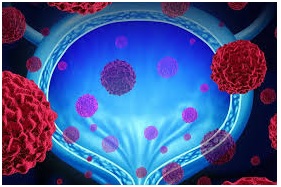WHAT IS BLADDER CANCER?
The bladder is where urine is stored before it leaves the body. Urine is a liquid waste produced by the kidneys.
Sometimes, the cells in our body do not behave as they should. This abnormal growth is cancer. In a person with bladder cancer, there is one or more growths or tumors (masses) made up of unhealthy and abnormal cells in the

WHAT CAUSES BLADDER CANCER?
- Smoking is a major risk factor
- Genetic factors
- The cancer drug cyclophosphamide
- Previous radiation to the pelvic area
- Occupational exposure to chemicals used in the production of plastics, paints, leather, and rubber

TYPES OF BLADDER CANCER
It is more appropriate to examine bladder cancer under two subheadings for follow-up and treatment purposes.
- Bladder cancer that does not reach the muscle layer is cancer that grows only in the thin tissue on the inner surface of the bladder. Here, the bladder muscle is not affected and the likelihood of the tumor spreading outside the bladder is low. There are many treatment options.
- Bladder cancer that involves the muscle tissue is cancer found in the thick muscle layer of the bladder wall. This is a more serious and advanced stage of bladder cancer. It may be necessary to remove the entire bladder.
Don't delay, let's meet now !
- Feneryolu Bagdat Avenue No 85/1 Postal Code: 34724 Kadıköy/İstanbul - Turkey
HOW DOES BLADDER CANCER GROW?
The bladder wall is made up of several layers of different types of cells. Most bladder cancer starts in the inner lining (inner surface) of the bladder, not in the bladder muscle.
Bladder cancer that does not reach the muscle layer does not grow beyond the bladder lining.
If there is cancer in the muscle tissue of the bladder, it will eventually grow into other layers of the bladder wall. Over time, the tumor may grow outside the bladder and spread to nearby tissues. The cancer may then spread to lymph nodes, the lungs, the liver, and other parts of the body.

WHAT ARE THE SYMPTOMS OF BLADDER CANCER?
- Blood in the urine (visible or microscopic bleeding)
- Frequent and urgent need to urinate
- Pain during urination
- Pain in the lower abdomen
Blood in urine is the most common symptom of bladder cancer. You may have blood in your urine without feeling any pain. Most of the time, the blood can only be seen under a microscope.
If you notice visible blood in your urine, do not ignore it. Even if the blood has stopped, inform your doctor immediately.
Blood in your urine does not always mean you have bladder cancer. There are many possible causes for blood in your urine. Tests can determine whether you have a urinary tract infection or a more serious condition, such as bladder cancer.

WHAT TESTS ARE USED FOR BLADDER CANCER?
Tests Specific to Bladder Cancer
- Urinalysis, urine cytology: A laboratory test of your urine to check for cancer cells.
- Cystoscopy: This allows your doctor to see inside your bladder. Your doctor inserts a tube with a camera (cystoscope) through the urethra into the bladder. This allows your doctor to clearly see the inner surface of the bladder.
Imaging Tests for Bladder Cancer
Imaging plays a very important role in both diagnosis and follow-up. It is used to determine the stage of cancer, control its spread, monitor how treatment is progressing, and/or detect whether cancer has returned after treatment.
Imaging for bladder cancer may include:
- CT (Computed Tomography) scan: Assesses the size and spread of the tumor, checks for spread to nearby organs, lymph nodes, or distant areas such as the lungs.
- MRI (Magnetic Resonance Imaging): Highly effective in detailing the local spread of a tumor in the pelvic region.
- PET/CT (Positron Emission Tomography/Computed Tomography):
Typically preferred if abnormal findings are detected in other imaging tests or if a biopsy cannot be taken from lymph nodes.
What are the stages and grades of bladder cancer?
The grade and stage of a tumor are two ways to measure and describe cancer.
Tumors can be low-grade or high-grade.
High-grade tumors are more likely to recur and progress more rapidly.
These cells are more likely to grow into the bladder muscle.
Doctors can determine the stage of bladder cancer using a small tumor sample taken during a TUR-MT (transurethral resection of the bladder tumor) procedure.
A pathologist carefully examines the sample under a microscope in a laboratory and determines the stage of the cancer.
The stages of bladder cancer are as follows:
- Ta: The tumor is located on the surface of the bladder and does not reach the muscle tissue.
- Tis (carcinoma in situ): This is a high-grade cancer. It appears as a reddish, velvety patch on the bladder lining.
- T1: The tumor passes through the bladder lining but does not reach the muscle layer.
- T3: The tumor invades the muscle layer of the bladder.
- T3: The tumor has spread beyond the muscle layer into the surrounding tissues of the bladder.
T4: The tumor comes into contact with or has spread to nearby structures such as the prostate in men or the vagina in women.
WHAT ARE THE TREATMENT OPTIONS FOR BLADDER CANCER?
Your treatment options will depend on the stage of your cancer and how much it has grown.
Treatment also depends on your overall health and age.
Your urologist will determine the stage and grade of your cancer and discuss with you how to manage your care based on your risk.
The risk may be low, moderate, or high.
- Treatment for Bladder Cancer That Has Not Reached the Muscle Layer
There are three main treatment methods.
If these methods do not produce good results, your doctor may recommend removal of the bladder.
- Transurethral resection of bladder tumors (TUR-MT)
- Intravesical drug instillation
- Intravesical immunotherapy (BCG)
- Intravesical chemotherapy
- TUR-MT
The TUR-MT procedure is performed using a cystoscope through the urethra; therefore, no incision is made in your abdomen.
You will be put to sleep or given medication (spinal anesthesia) to numb the nerves in your lower back.
Your doctor will use a cystoscope to view the inside of your bladder, take tumor samples, and remove all visible tumor tissue (resection).
The doctor may also take very small samples from other areas of the bladder that appear abnormal.
These samples will be examined to determine the grade and stage of the tumor.
The TUR-MT procedure may need to be performed more than once to ensure that all cancer has been removed.
- Intravesical Drug Administration (Intravesical Therapy)
Intravesical (bladder) treatment involves administering a therapeutic drug into the bladder via a catheter (a thin tube inserted through the urethra).
You keep the medication in the bladder for 1–2 hours and then expel it through urination.
Intravesical treatment methods include:
Intravesical Immunotherapy
Immunotherapy is a treatment that enhances your immune system's ability to fight cancer.
BCG (Bacillus Calmette-Guérin) is an immunotherapy drug used to treat bladder cancer.
You may receive this treatment multiple times, and some patients receive several courses of BCG.
The first course typically lasts about six weeks.
BCG is administered once a week into your bladder.
This treatment is usually performed in a doctor's office; a hospital or operating room is not required.
Once the disease is no longer present in the bladder, your doctor may recommend additional treatment with the same medication to prevent the tumor from returning.
Intravesical Chemotherapy
Intravesical chemotherapy is usually administered immediately after surgery.
Mitomycin-C and gemcitabine are the most commonly used drugs in intravesical chemotherapy.
These drugs kill cancer cells and are administered directly into the bladder via a catheter.
- Muscle-Invasive Bladder Cancer (MIBC) Treatment
There are two main options for treatment of MIBC:
- Removal of the bladder (radical cystectomy) – with or without chemotherapy.
As a less common option, partial cystectomy, which involves removing only the tumor-containing portion, may also be performed. - Trimodal (triple-combination) therapy – TUR-MT procedure combined with chemotherapy and radiation therapy.
- REMOVAL OF THE BLADDER
In patients with bladder cancer that has not reached the muscle layer, removal of the bladder may be recommended when other treatments have failed or when there is a high risk of recurrence or spread to the muscle and beyond.
In patients with muscle-invasive bladder cancer (MIBC), removal of the bladder is generally recommended.
Options for Bladder Removal Surgery:
Partial Cystectomy (Partial Bladder Removal)
In this surgery, the doctor removes only part of the bladder.
Partial cystectomy is recommended only if the tumor in the bladder is confined to a specific area and does not affect other parts of the bladder.
Radical Cystectomy (Complete Bladder Removal)
Radical cystectomy is the surgical removal of the entire bladder.
This surgery is typically performed for superficial bladder cancer when other treatments are ineffective.
It is the most common surgical option for bladder cancer with muscle involvement.
During this surgery, the doctor may remove the following:
- The entire bladder
- Part or all of the urethra
- Nearby lymph nodes
- In men: The prostate
- In women: The uterus, ovaries, fallopian tubes, and part of the vagina
Other nearby tissues may also be removed or left in place in some cases.
When the bladder is removed, a new pathway is needed to store and expel urine from the body.
This is called urinary diversion. It is often achieved by creating a reservoir from the intestine. The newly created bladder is then connected to the abdomen (ideal conduit) or to the normal urinary tract (urethra) (orthotopic neobladder), depending on the patient's condition and the nature of the disease.
- TRIMODAL THERAPY (TRIPLE COMBINATION THERAPY)
- TUR-MT
- Radiotherapy
- Chemotherapy
If radical cystectomy (complete removal of the bladder) is not possible or not desired, your doctor may recommend this protective treatment for the bladder.
Before starting chemotherapy and radiation therapy, your surgeon will remove as much of the tumor as possible during the TUR-MT procedure. This is done to remove as much cancer as possible.
Radiotherapy is given in combination with chemotherapy for patients with muscle-invasive bladder cancer (MIBC) following TUR-MT surgery.
The combination of radiation therapy and chemotherapy is part of a three-pronged treatment approach (trimodal therapy) aimed at preserving the bladder.
FOLLOW-UP PROCESS AFTER BLADDER CANCER TREATMENTS
After treatment is completed, the follow-up process may include the following:
- Cystoscopy examinations
- Urinalysis
- Imaging tests (such as CT or MRI scans)
If you have undergone a cystectomy, your recovery will take time.
Each person's recovery time is different.
It is normal to feel weak or tired for a while.
As with all major surgeries, there may be some complications with bladder surgery.
Here are some things you can do to feel better:
- If you smoke, seek help to quit.
- Start exercising with your doctor's approval.
- Adopt a healthy diet that includes more fruits and vegetables.
- Remember that bladder cancer is a type of cancer that often recurs. Therefore, never skip your follow-up appointments.
